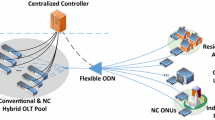Abstract
A novel architecture of optical code (OC) label generation and recognition for optical packet switching (OPS) by using super structured fiber Bragg grating (SSFBG) is proposed. The OC label is generated and recognized by a label generator and recognizer, respectively. The label generator is composed of N encoders in parallel, and it can generate 2N kinds of serial optical code labels (SOCLs) for indicating 2N network routing information. The label recognizer can decode SOCLs by N decoders in parallel and provides label information to the switching control unit so that clock information is not required during the decoding process. In the switch nodes, handling of the high-speed information payload stream and the recognition of the OC label are performed in the optical domain, while processing of the routing information remains in the electrical domain. This approach could be a promising solution for an OPS network with high capacity, good quality of service (QoS), multi-service function and high security. In this experiment, we demonstrate 40 Gbps 256 label optical packet switching that employs clockless SOCL processing.
Similar content being viewed by others
References
Kitayama K, Wang X, Wada N. OCDMA over WDM PON-solution path to gigabit-symmetric FTTH. Journal of Lightwave Technology, 2006, 24(4): 1654–1662
Yuang M, Chao I, Lo B, Tien P, Chen J, Wei C, Lin Y, Lee S S W, Chien C. HOPSMAN: an experimental testbed system for a 10-Gb/s optical packet-switched WDM metro ring network. IEEE Communications Magazine, 2008, 46(7): 158–166
Yuang M C, Lee S S W, Tien P L, Lin Y M, Shih J, Tsai F, Chen A. Optical coarse packet-switched IP-over-WDM network OPSINET: technologies and experiments. IEEE Journal on Selected Areas in Communications, 2006, 24(8): 117–127
Li H, Thng I L J. Cost-saving two-layer wavelength conversion in optical switching network. Journal of Lightwave Technology, 2006, 24(2): 705–712
Liboiron-Ladouceur O, Small B A, Bergman K. Physical layer scalability of WDM optical packet interconnection networks. Journal of Lightwave Technology, 2006, 24(1): 262–270
Tian C, Zhang Z, Ibsen M, Petropoulos P, Richardson D J. Demonstration of a 16-channel code-reconfigurable OCDMA/DWDM system. In: Proceedings of OFC. 2007, OMO
Parmigiani F, Oxenløwe L K, Galili M, Ibsen M, Zibar D, Petropoulos P, Richardson D J, Clausen A T, Jeppesen P. All-optical 160-Gbit/s retiming system using fiber grating based pulse shaping technology. Journal of Lightwave Technology, 2009, 27(9): 132–140
Wang X, Matsushima K, Nishiki A, Wada N, Kitayama K. High reflectivity superstructured FBG for coherent optical code generation and recognition. Optics Express, 2004, 12(22): 5457–5468
Chi N, Xu L, Christiansen L, Yvind K, Zhang J, Holm-Nielsen P, Peucheret C, Zhang C, Jeppesen P. Optical label swapping and packet transmission based on ASK/DPSK orthogonal modulation format in IP-over-WDMnetworks. In: Proceedings of OFC. 2003, 2: 792–794
Yu J, Chang G K, Chowdhury A. Instantaneous clock recovery for burst-mode optical label and payload by using a conventional data receiver. In: Proceedings of OFC. 2005, 3: OWK6
Cao J, Jeon M, Pan Z, Bansal Y, Wang Z, Zhu Z, Hernandez V, Taylor J, Akella V, Yoo S, Okamoto K, Kamei S. Error-free multihop cascaded operation of optical label switching routers with alloptical label swapping. In: Proceedings of OFC. 2003, 2: 791–792
Sasaki K, Sarashina M, Kobayashi S, Tamai H, Nishiki A, Ushikubo T. A new π/2-shift-BPSK signal by superstructure fibre Bragg grating en/decoder. In: Proceedings of ECOC. 2005, 3: 595–596
Sarashina M, Tamai H, Sasaki K, Kashima M. Demonstration of asynchronous ultrahigh speed optical label switching using SSFBGs label recognizer. In: Proceedings of OFC. 2006, JThB56
Parmigiani F, Oxenlowe L K, Galili M, Ibsen M, Zibar D, Petropoulos P, Richardson D J, Clausen A T, Jeppesen P. All-optical 160-Gbit/s RZ data retiming system incorporating a pulse shaping fibre Bragg grating. In: Proceedings of ECOC. 2007, 16–20
Parmigiani F, Petropoulos P, Ibsen M, Richardson D J. Pulse reshaping and retiming systems incorporating pulse shaping fiber Bragg grating. Journal of Lightwave Technology, 2006, 24(1): 357–364
Wang X, Wada N, Miyazaki T, Cincotti G, Kitayama K. Field trial of 3-WDM×10-OCDMA_10.71-Gb/s asynchronous WDM/DPSK-OCDMA using hybrid E/D. Journal of Lightwave Technology, 2007, 25(1): 207–215
Parmigiani F, Finot C, Mukasa K, Ibsen M, Roelens M A F, Petropoulos P, Richardson D. Ultra-flat SPM-broadened spectra in a highly nonlinear fiber using parabolic pulses formed in a fiber Bragg grating. Optics Express, 2006, 14(17): 7617–7622
Wang X, Matsushima K, Kitayama K, Nishiki A, Wada N, Kubota F. High performance optical code generation and recognition by use of a 511-chip 640-Gchip/s phase-shifted superstructured fiber Bragg grating. Optics Letters, 2005, 30(4): 355–357
Wang X, Matsushima K, Nishiki A, Wada N, Kitayama K. High reflectivity superstructured FBG for coherent optical code generation and recognition. Optics Express, 2004, 12(22): 5457–5468
Wang X, Kataoka N, Wada N, Miyazaki T, Cincotti G, Kitayama K. Flexible 10 Gbps, 8-user DPSK-OCDMA system with 16×16 ports encoder and 16-level phase-shifted SSFBG decoders. In: Proceedings of OFC. 2008, OMR2
Wang X, Kitayama K. Analysis of beat noise in coherent and incoherent time-spreading OCDMA. Journal of Lightwave Technology, 2004, 22(10): 2226–2235
Author information
Authors and Affiliations
Corresponding author
Rights and permissions
About this article
Cite this article
Li, B., Luo, F., Yu, Z. et al. A novel architecture of optical code label generation and recognition for optical packet switching. Front. Optoelectron. China 3, 347–353 (2010). https://doi.org/10.1007/s12200-010-0118-5
Received:
Accepted:
Published:
Issue Date:
DOI: https://doi.org/10.1007/s12200-010-0118-5




